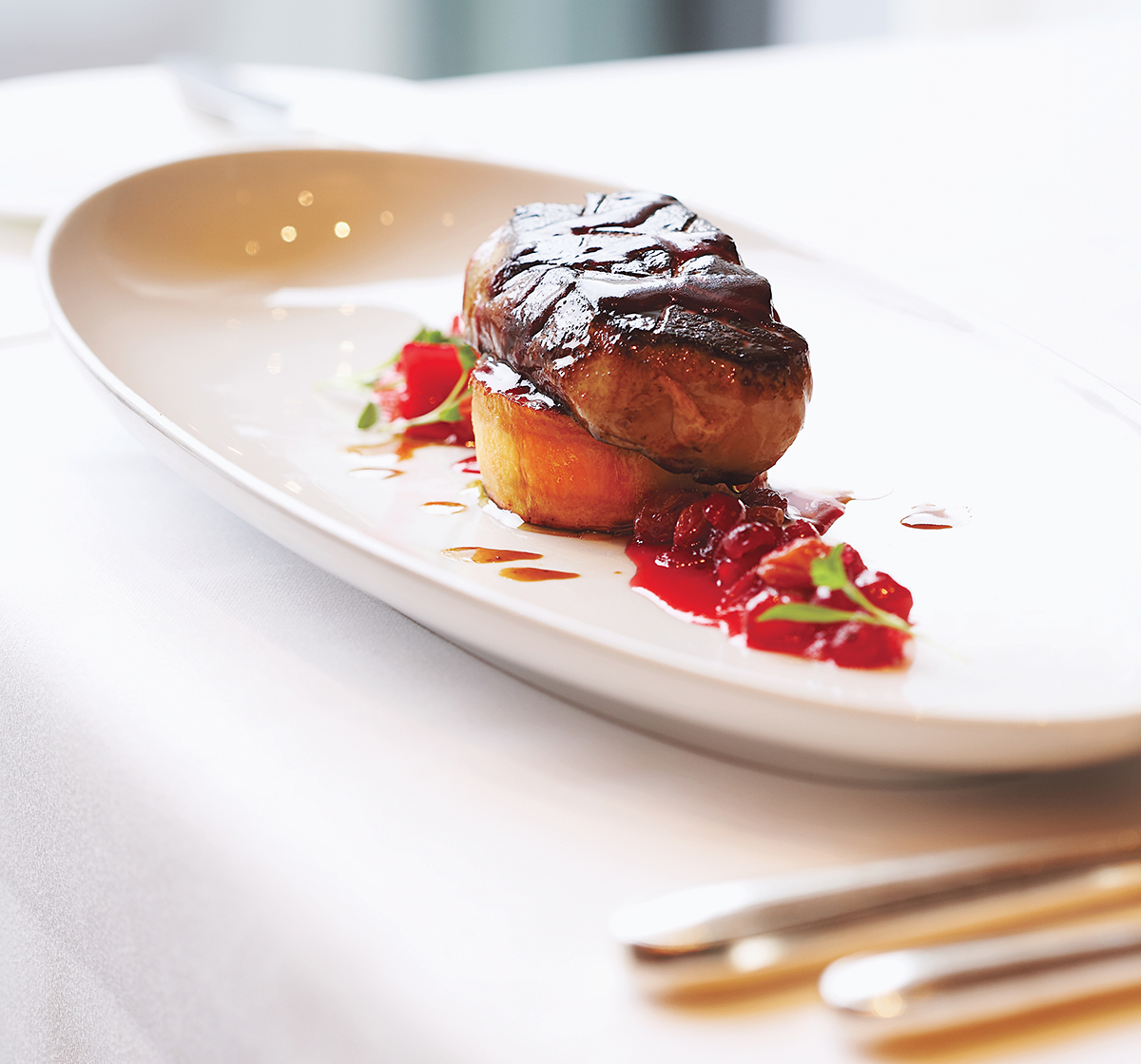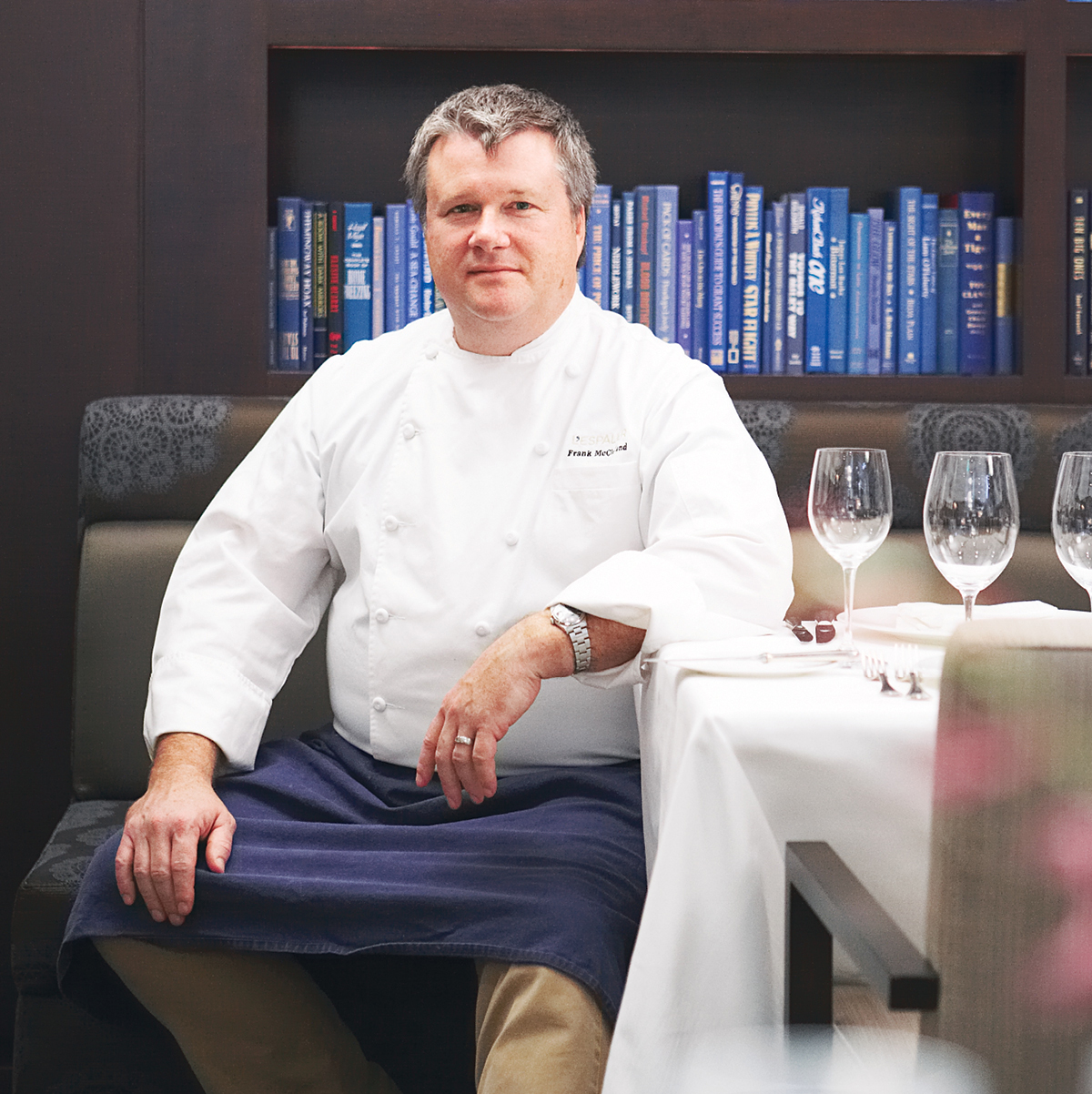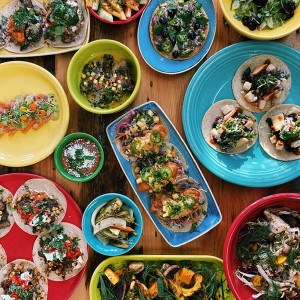Dining Out: L’Espalier

Roasted Hudson Valley foie gras, perched on a round of braised sweet potato with a sweet-tart cranberry-ginger relish. (Photograph by Keller + Keller)
Boston might still have a place for a luxury restaurant where no request is too large and your every whim is intuited. And that place, logically, would be the Mandarin Oriental, the new Back Bay hotel that aims to elbow aside (ever so delicately, of course) the Four Seasons. It is not by coincidence that it was masterminded by the man who put the Four Seasons front and center in Boston, Robin Brown.
L’Espalier, with its history of cosseting diners in a grand, romantic townhouse a few blocks away, was the obvious dining anchor, and luring it to the Mandarin was a coup. On the few occasions I ate at the Gloucester Street location, all of them a good 10 years ago, I found the food beautifully prepared, if mostly unmemorable. But I always admired chef-owner Frank McClelland’s dedication to technique, as well as his knack for finding local ingredients before they were the rage—he grew up in New Hampshire farm country—and pairing food with the right wine (as he does in his recent book, Wine Mondays).
The new place is modern and very brown, with big windows that give a perfect view of the brightly lit Lord & Taylor sign across the street—not a swatch of chintz or Louis-anything in sight. It’s really the space between the tables you’re paying for. That, and the service: Many of the staffers come from the old L’Espalier and know the menu and wine list inside out; the longtime host, Louis Risoli, is a master of the glass-topped cheese cart and persuasively describes the selection of little-known Vermont (and some French and other European) cheeses. It feels good to be here, even if sometimes the attentive service is a little too much so—as when it races you to the one-seat bathroom to hold the door open.

Maitre d’ and fromager Louis Risoli, with L’Espalier’s esteemed cheese cart. (Photograph by Keller + Keller)
All this attention comes at a high price. Too high. Dinner is prix fixe only, with options starting at three courses for $82, and climbing from there (vegetarian for $90, “Tasting Journey” for $185, and full tasting with wine pairings for $295). I was vaguely aware there was an additional charge for cheese, but I had no notion the “grand fromage” would add $36 to the bill. Unless L’Espalier intends to attract only superrich hotel guests, it may find that in the current economy, locals are limited to lunch, which is $35 for three courses. Wines are mostly $60 and up, though we had an excellent nero d’Avola for $40, and the wine steward was unfazed when we asked for something low-priced.
I did manage to taste almost everything on the fall menu, and found the food more adventurous than I remembered, while still based on rock-solid French technique. Seasoning and the use of dried and fresh herbs is delicate and exemplary—chefs should come for lessons. A spoonful of the butter, stock, and black truffle reduction under the roast chicken breast with pancetta will make you sit back and sigh, Ah, France.
Another L’Espalier hallmark has been a freewheeling willingness to try unexpected pairings—what in its heyday was called New American cuisine. Added now are a few of the science-food techniques that cooks like Grant Achatz and Wylie Dufresne are using in Chicago and New York, respectively. This openness to the new characterizes the restaurant’s greatest current successes—and its greatest failures.
My favorite dish, frankly, sounded strange: an appetizer of veal sweetbreads on a whole-wheat waffle with pink grapefruit and citrus yogurt. The three sweetbreads were perfectly crisp on the outside and soft but not spongy. The waffle added crunch, and the citrus a sweet-and-sour note. It was both interesting and beautifully executed. So was the seared, roasted foie gras on top of a disk of sweet potato braised in butter and chicken stock, the foie gras finished with brandy, cranberries, and raisins (fruit, in fact, adorns much on the menu). A few of the generously portioned appetizers could happily make a meal.

L’Espalier chef-owner Frank McClelland, in his restaurant’s tony new setting. (Photograph by Keller +Keller)
But you’re paying for the entrées, and too many were letdowns. The elk, a meat that deserves a wider audience for its lean tenderness, was flavorless and (yuckily) paired with escargots and a chocolate–tangerine sauce. The lamb tasted far more of its Thai spices and roasted pineapple than lamb. The Scottish squab tasted more like meat than anything else I tried (I didn’t have the tenderloin with short ribs), but it was dry. So was the Blue Foot chicken at one dinner, though another time the meat was perfect, and both times there was that wonderful jus. I didn’t order the monkfish a second time, because I was so discouraged by its rubbery, underdone texture the first. The best of the fish was a light-tasting “lemon snapper,” a Hawaiian import also called ono, with couscous, pine nuts, and raisins and a Meyer lemon–white anchovy dressing to offset the sweet fruit.
Desserts lean too far toward the experimental. The greasy bacon-infused caramel on the gummy pineapple upside-down cake is best avoided; black-pepper ice cream with an “apple tart” (a bland roulade) is reach-for-the-water overwhelming. Better bets are the chocolate offerings. The acid-sweet balance of the chocolate terrine was perfect, and the mocha soufflé was textbook crisp-soft.
If only you could order à la carte, and have some appetizers and that grand cheese platter, all a bit more modestly priced! (Soon, maybe, if the grandees at the Mandarin thin out?) The service and much of the cuisine at L’Espalier is, in its homegrown way, splendid. I want to be able to afford to go back.

The BlueFoot chicken with truffled jus. (Photograph by Keller + Keller)
CORBY’S PICKS
Appetizers*: Veal sweetbreads on a whole-wheat waffle with pink grapefruit and citrus yogurt; seared and roasted foie gras atop a disk of sweet potato
Entrées*: “Lemon snapper” (ono) with couscous, pine nuts, raisins, and Meyer lemon–white anchovy dressing
Desserts*: Chocolate terrine; mocha soufflé
Cheeses: “Grand fromage” platter ($36)
*Offerings in L’Espalier’s prix fixe dinners ($82–$185)
Critic Corby Kummer—an editor at The Atlantic and author of The Pleasures of Slow Food—has been scrutinizing the city’s leading restaurants in our pages since 1997.


